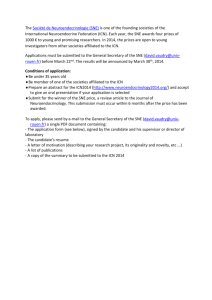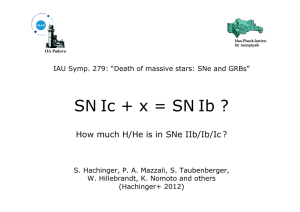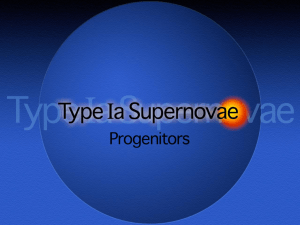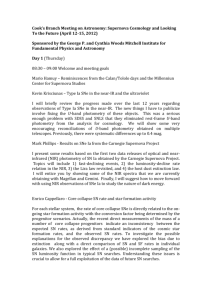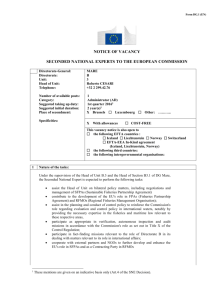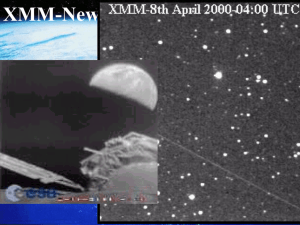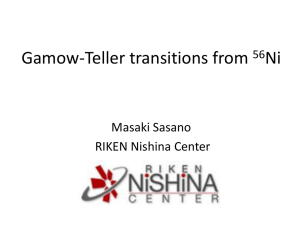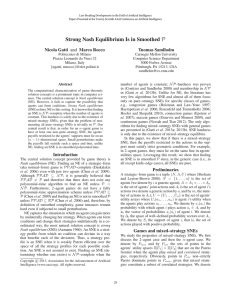Andy Howell University of Toronto And the Supernova
advertisement
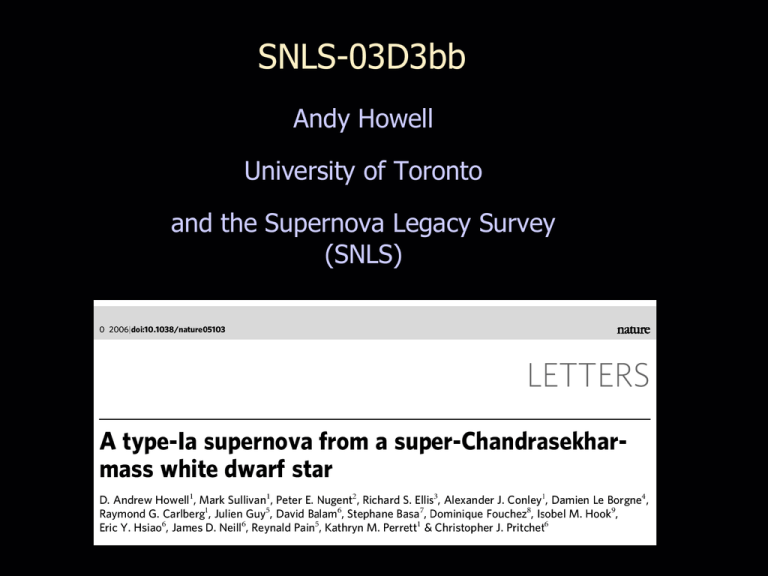
SNLS-03D3bb Andy Howell University of Toronto and the Supernova Legacy Survey (SNLS) Host HST z = 0.2440 From PEGASE 2 fits to host ugriz photometry: CFHT 0.81 log M gal 8.930.50 0.02 SFR 1.26 1 M yr-1 Formally implies host age of 0.7 Gyr, though highly uncertain 0.81 log M gal 8.930.50 CFHT Si II velocity Low-z data from Benetti et al. 2005 Lightcurve V=20.5 ± 0.06 MV = -19.94 ± 0.06 Use only r, i fit s = 1.13 Sparse LC from early days of survey V magnitude distribution MV = -19.94 ± 0.06 2.2 times the luminosity of median SN Ia Low-z Astier et al. sample 56Ni mass Arnett’s rule: Luminosity at maximum is proportional to spontaneous energy deposition by radioactive decay. M Ni L bol = α S (t r ) : ratio of bolometric to radioactivity luminosities S : energy per second per solar mass from radioactive deacay = 6.3110 43 e tr /8.8 +1.43 10 43 e tr /111 erg s-1 M-1 S Using tr = -19.5 (Conley et al. 2006), = 1.2 (Nugent et al. 1996), get MNi = 1.29 ± 0.07 M Velocity from kinetic energy KE is nuclear energy minus binding energy v ke = 2 (E n E b ) M WD 3 kinds of elements: Fe-peak, IME, unburned C/O Energy from burning to Fe peak: E Fe = 1.55 10 51 erg s-1 M-1 Burning to Si produces 76% as much E n = E Fe M W D (f Fe + 0.76 f IME ) 56Ni is 70% of Fe-peak elements: M Ni 0 . 7 M WD f Fe Binding energy (Yoon & Langer 2005) - 1.4 M WD: 0.5e51 erg - 2.0 M WD: 1.3e51 erg Implications - Progenitors • Double degenerate model: merger of two massive WDs can produce superChandra product. In youngest populations, only massive WDs exist. Before 0.9 Gyr, combined WD mass must be > Chandrasekhar mass. • Single degenerate model: rapid rotation could support 2 solar mass WD according to Yoon & Langer 2005. Young pop. favored for higher starting WD, secondary masses. Implications • The most luminous SNe occur in young populations • Super-Chandra model predicts more luminous SNe in younger populations • Chandra model has no explanation for this. • Could WD mass partially drive luminosity fluctuations in SNe Ia? Conclusions - Observations • MV=19.94 ± 0.06, brightest SN Ia ever observed (with the possible exception of the interacting SN 2002ic) • SiII velocity at +2d among the lowest seen, 8000 km/s • SiII strong relative to CaII at +2d, in contrast with other SNe Ia • CII near maximum implies the presence of unburned material deep into the SN • Low-mass, blue host implies a young progenitor age Conclusions - Interpretation • Arnett’s law implies ~1.3 M 56Ni. • If ~40% of elements are non-56Ni, MWD ~ 2.1 M • High 56Ni mass implies large nuclear energy, which should produce large velocities in Chandrasekhar model. • Low velocity consistent with increased binding energy of super-Chandra model. • Young galaxy consistent with expectations from Super-Chandra model • SNLS-03D3bb meets every expectation of the superChandra model Conclusions - Cosmology • WD mass may partially drive SN Ia luminosity • SNLS-03D3bb does not follow stretchluminosity relationship (it is too bright by 4.4 sigma). • “Evolution” in SNe with redshift? • SNLS-03D3bb was thrown out of Astier et al. (2006), but less extreme examples could be in data set.

